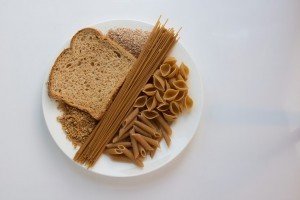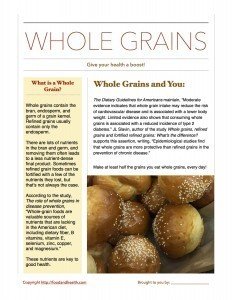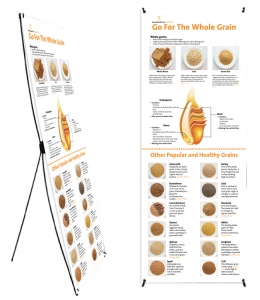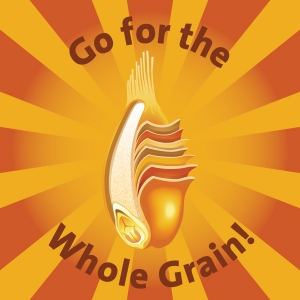Whole Grain Facts
 Celebrate Whole Grains Month with some whole grain facts!Whole grains contain the bran, endosperm, and germ of a grain kernel. Refined grains usually contain only the endosperm. There are lots of nutrients in the bran and germ, and removing them often leads to a less nutrient-dense final product. Sometimes refined grain foods can be fortified with a few of the nutrients they lost, but that's not always the case.So, what nutrients do whole grain foods contain?According to the study, The role of whole grains in disease prevention, "Whole-grain foods are valuable sources of nutrients that are lacking in the American diet, including dietary fiber, B vitamins, vitamin E, selenium, zinc, copper, and magnesium." These nutrients are key to good health. After all, according to the Dietary Guidelines for Americans, "Moderate evidence indicates that whole grain intake may reduce the risk of cardiovascular disease and is associated with a lower body weight. Limited evidence also shows that consuming whole grains is associated with a reduced incidence of type 2 diabetes." JL Slavin, author of the study Whole grains, refined grains and fortified refined grains: What’s the difference? supports this assertion, maintaining "Epidemiological studies find that whole grains are more protective than refined grains in the prevention of chronic disease."
Celebrate Whole Grains Month with some whole grain facts!Whole grains contain the bran, endosperm, and germ of a grain kernel. Refined grains usually contain only the endosperm. There are lots of nutrients in the bran and germ, and removing them often leads to a less nutrient-dense final product. Sometimes refined grain foods can be fortified with a few of the nutrients they lost, but that's not always the case.So, what nutrients do whole grain foods contain?According to the study, The role of whole grains in disease prevention, "Whole-grain foods are valuable sources of nutrients that are lacking in the American diet, including dietary fiber, B vitamins, vitamin E, selenium, zinc, copper, and magnesium." These nutrients are key to good health. After all, according to the Dietary Guidelines for Americans, "Moderate evidence indicates that whole grain intake may reduce the risk of cardiovascular disease and is associated with a lower body weight. Limited evidence also shows that consuming whole grains is associated with a reduced incidence of type 2 diabetes." JL Slavin, author of the study Whole grains, refined grains and fortified refined grains: What’s the difference? supports this assertion, maintaining "Epidemiological studies find that whole grains are more protective than refined grains in the prevention of chronic disease." So. Whole grains can play a key role in good health by reducing the risk of chronic disease. What else can they do? Well, it turns out that whole grain foods are also higher in protein than their refined grain counterparts (source) and they have more fiber too.Why is fiber important?To answer that question, we turn to another study. The authors of Health benefits of dietary fiber, found that "Individuals with high intakes of dietary fiber appear to be at significantly lower risk for developing coronary heart disease, stroke, hypertension, diabetes, obesity, and certain gastrointestinal diseases. Increasing fiber intake lowers blood pressure and serum cholesterol levels. Increased intake of soluble fiber improves glycemia and insulin sensitivity in non-diabetic and diabetic individuals. Fiber supplementation in obese individuals significantly enhances weight loss." So fiber can help reduce the risk of heart disease, stroke, diabetes, and some digestive diseases, along with aiding weight loss, blood pressure and cholesterol control, while also improving insulin sensitivity. That is one handy nutrient!Unfortunately, most Americans do not get enough of it. According to the Dietary Guidelines for Americans, "Most Americans greatly underconsume dietary fiber, and usual intake averages only 15 g per day." Those same guidelines assert that "The AI [adequate intake] for fiber is 14 g per 1,000 calories, or 25 g per day for women and 38 g per day for men."
So. Whole grains can play a key role in good health by reducing the risk of chronic disease. What else can they do? Well, it turns out that whole grain foods are also higher in protein than their refined grain counterparts (source) and they have more fiber too.Why is fiber important?To answer that question, we turn to another study. The authors of Health benefits of dietary fiber, found that "Individuals with high intakes of dietary fiber appear to be at significantly lower risk for developing coronary heart disease, stroke, hypertension, diabetes, obesity, and certain gastrointestinal diseases. Increasing fiber intake lowers blood pressure and serum cholesterol levels. Increased intake of soluble fiber improves glycemia and insulin sensitivity in non-diabetic and diabetic individuals. Fiber supplementation in obese individuals significantly enhances weight loss." So fiber can help reduce the risk of heart disease, stroke, diabetes, and some digestive diseases, along with aiding weight loss, blood pressure and cholesterol control, while also improving insulin sensitivity. That is one handy nutrient!Unfortunately, most Americans do not get enough of it. According to the Dietary Guidelines for Americans, "Most Americans greatly underconsume dietary fiber, and usual intake averages only 15 g per day." Those same guidelines assert that "The AI [adequate intake] for fiber is 14 g per 1,000 calories, or 25 g per day for women and 38 g per day for men." Luckily, many whole grain foods are great sources of fiber. Shopping for Whole Grains: A Guide has a great look at fantastic whole grain foods that are easy to access and incorporate into an eating plan, while Go for the Whole Grain has a free chart that compares fiber content in a single serving of grain foods. Check out those blog posts or send them along as references for your clients.No Whole Grains Month celebration would be complete without some fun whole grain trivia, so here are some fun facts from around the web...
Luckily, many whole grain foods are great sources of fiber. Shopping for Whole Grains: A Guide has a great look at fantastic whole grain foods that are easy to access and incorporate into an eating plan, while Go for the Whole Grain has a free chart that compares fiber content in a single serving of grain foods. Check out those blog posts or send them along as references for your clients.No Whole Grains Month celebration would be complete without some fun whole grain trivia, so here are some fun facts from around the web...
- Brown rice is super high in manganese. A single cup of it offers over 80% of the Daily Value (DV) for this vital nutrient.
- Do you have chicken pox, eczema, or a bad sunburn? Try taking an oatmeal bath! Adding 1 cup of finely-ground oatmeal to your bathwater can soothe inflamed skin.
- Wheat was one of the first cereal grains to be domesticated.
- Amaranth, rice, oatmeal, and quinoa are all gluten-free whole grains.
- Quinoa plants can survive droughts that kill many other plants.
- 3/4 of American households have oatmeal somewhere in their pantry.
- Wheat self-pollinates.
- Popcorn is a whole grain! It contains the bran, endosperm, and germ.
And now it's time for the best part -- the handout! Check out this phenomenal guide to whole grains... Whole Grains Month is so fun to celebrate that I've loaded the Nutrition Education Store with whole grain educational materials. Here are a few favorites...
Whole Grains Month is so fun to celebrate that I've loaded the Nutrition Education Store with whole grain educational materials. Here are a few favorites...




